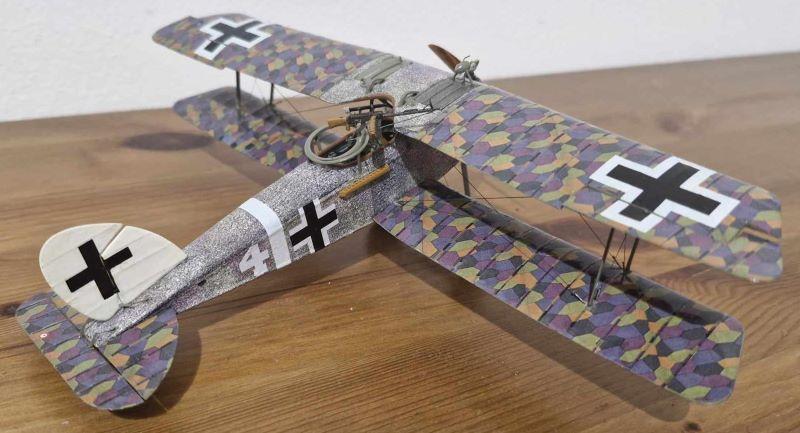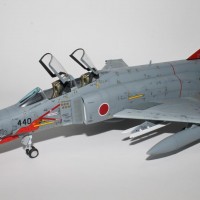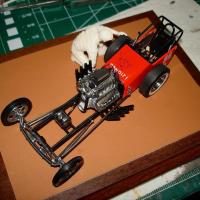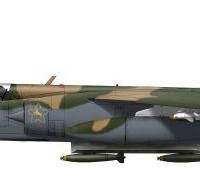Halberstadt Cl. II, Mirage Hobby, 1:48, Uzfw. Huffzky and Vzfw. Gottfried Ehmann, Shlasta 15, 9 and 12 victories
Finally, after almost two months of hiatus, I finally got around to finishing a long-standing model. A relatively more demanding build, mainly due to the more complex coloring that Halberstadts are known for. The propeller is made of wood again and a few small details are made again. The engine has been supplemented with small details.
The Halberstadt CL.II was a German two-seat escort fighter/ground attack aircraft of World War I. It served in large numbers with the Luftstreitkräfte in 1917–18.
In early 1917, the Idflieg, the German Army Flying Corps Inspectorate, developed a requirement for a new type of two-seat aircraft, smaller than the existing C-type aircraft. This type, known as the CL (Light C type), was to be used to equip Schutzstaffeln (protection squadrons) to escort reconnaissance aircraft. Halberstadt developed an aircraft based on its earlier unsuccessful single-seat Halberstadt D.IV fighter to meet this requirement. Originally designated the Halberstadt C.II, it was redesignated the Halberstadt CL.II when the CL designation was used. The CL.II passed the Typenprüfung (type test) on 7 May 1917, leading to the placing of production orders. Halberstadt built 700 CL.IIs before production switched to the improved CL.IV in mid-1918. A further 200 CL.IIs were built in 1918 by Bayerische Flugzeug-Werke (BFW).
The CL.II entered service in August 1917 and proved highly successful; its excellent handling, rate of climb and promising field of fire for its armament enabled it to match enemy single-seat fighters. It also proved suitable for close support, which became the primary role of the CL type, and the units that operated them were renamed Schlachtstaffeln (Battle Squadrons).
Ground support by the Schlachtstaffeln proved highly effective, being used to support German attacks and disrupt enemy attacks. The first successful use of CL aircraft in a ground attack role was during the German counter-attack on 30 November 1917 at the Battle of Cambrai, where they were a significant factor in the German performance. The success of German tactics at Cambrai, including the use of close air support, led to the Germans assembling large numbers of CLs in support of the Spring Offensive in March 1918, with 38 British Schlachtstaffeln (equipped with CL.II, CL.IV and Hannover CL.III) available, of which 7 Michael units were deployed during the initial attack. The CL.II continued in service until the end of the war.
Vizefeldwebel Gottfried Ehmann was a German flying ace from World War I, who claimed twelve aerial victories.
Ehmann was assigned as a gunner/observer in the German two-seater unit Schlachtstaffel 15. As a Flieger, he and a pilot named Warda combined for three victories, on October 30, 1917, March 21, and April 24, 1918. They were also promoted twice – to Gefreiter and Unteroffizier – and awarded the Iron Cross, Second Class. Ehmann was then paired with Friedrich Huffzky in the Halberstadt CL.II. Between 4 June and 29 July 1918, the duo scored a series of nine victories, making them the most successful German two-seater team of the war. This also made Ehmann the top German two-seater gunner. These feats were recognized with the award of the Iron Cross 1st Class, the Military Merit Cross in Gold (9 August 1918), and also the Gold and Silver Decorations of the Württemberg Military Merit Order.
Feldwebel Friedrich Huffzky was a German flying ace during World War I. He was the pilot of the most successful two-seater German fighter crew of the war, scoring nine confirmed aerial victories.
Friedrich Huffzky is known to have been assigned to Schlachtstaffel 15 Luftstreitkräfte in early 1918 as a Vizefeldwebel. He flew the Halberstadt CL.II escort fighter. Teamed with Gottfried Ehmann, an experienced gunner who had already claimed three victories, Huffzky began his winning streak on 4 June 1918. By 29 July 1918, he had extended his streak to nine confirmed victories; in the process, Ehmann had claimed a total of 12 victories, becoming the most successful German gunner of the war. Huffzky was awarded both classes of the Iron Cross for his efforts, as well as promotion to Feldwebel.












Always a pleasure to see one of your masterpieces, Milan! Well researched and built excellently!
Congratulations!
Thank you Friend! I'm glad you like my models.
Your Halberstadt CL.II is fantastic, and is definitely a MASTERPIECE of modeling excellence.
Congratulations on your superb work!
Marvin, thank you for the compliment.
Another Beauty! Steller job, Milan
Thank you Friend!
This is really impressive, Milan @milantesar
All those details and this exceptional camouflage makes it one of your best models.
Thank you Friend!
Build, finish, and details come together to produce a spectacular, highly realistic model. And having the photo of the pilot & gunner...WOW.
Thank you Bob.
Really like that paint scheme. Thanks for sharing.
Rod
Thank you Rod.
The rigging, the paintjob...everything so clean and crips, fantastic job, Milan @milantesar!
Thank you Felix.
Wow! What fantastic work and such a superb result.
You have convinced me I have to pull mine out finally after 15 years "marinating" in the Box O' Doom.
Thank you Tom, definitely take it out. It's a good kit despite its laboriousness.
Absolutely outstanding work. You're a master modeler, Milan.
Thank you Eric, I appreciate your compliment.
Lovely work, Milan... well worth waiting a little longer for the end result. Beautiful - very well done... ;-).
Thank you Paul, one of my most difficult models and I'm so glad you like it.
A real beauty! She is a sleek-looking aircraft with that slender nose.
Thank you Greg.
That's a spectacular build, great details. Love the wood prop.
Thank you Chas.
Once again you have built an outstanding model Milan, the narrative shows great research. An excellent achievement.
Thank you Friend.